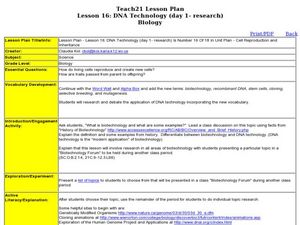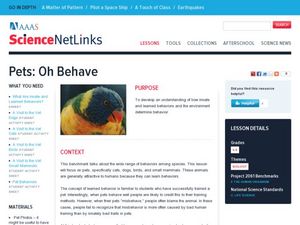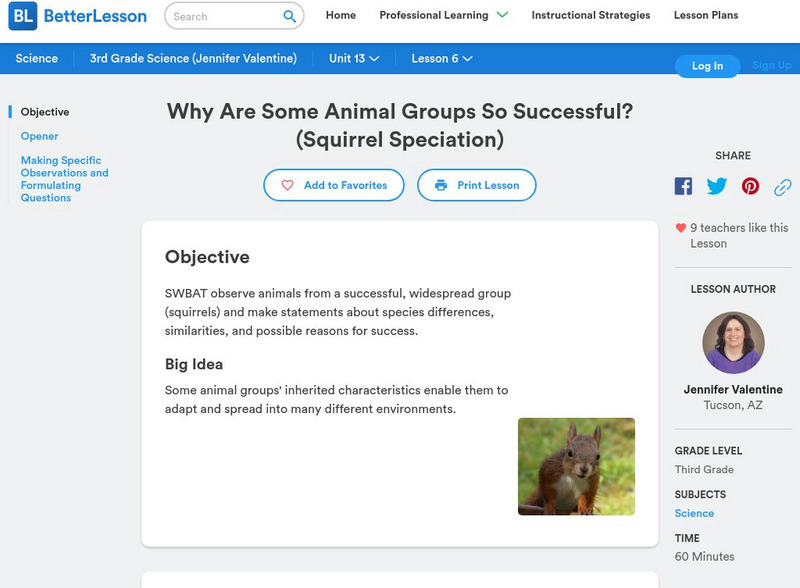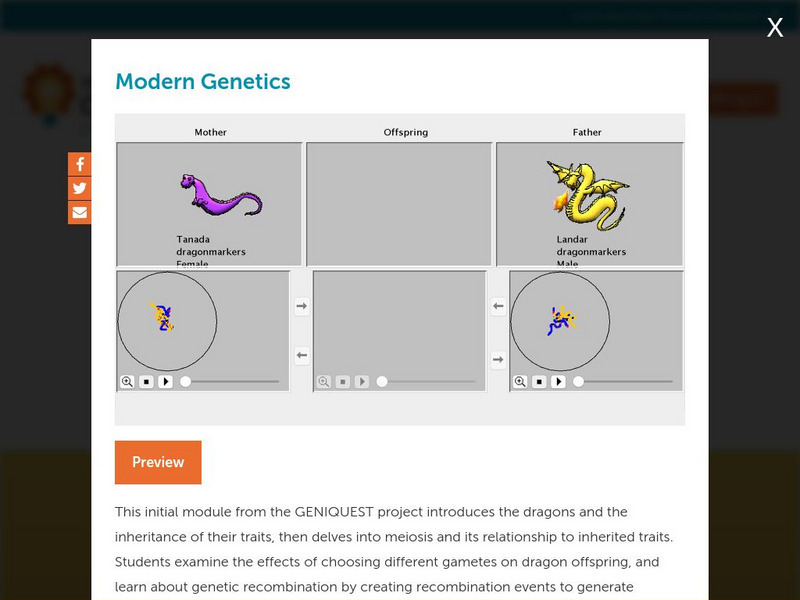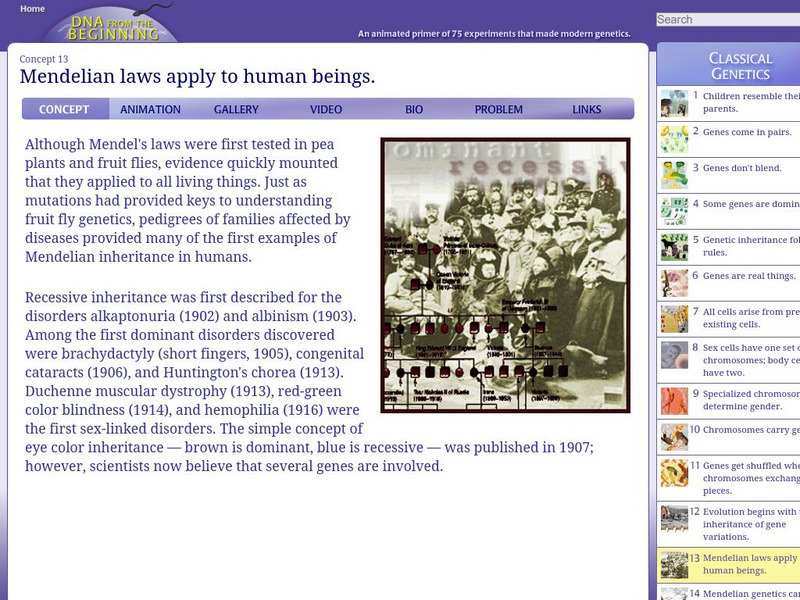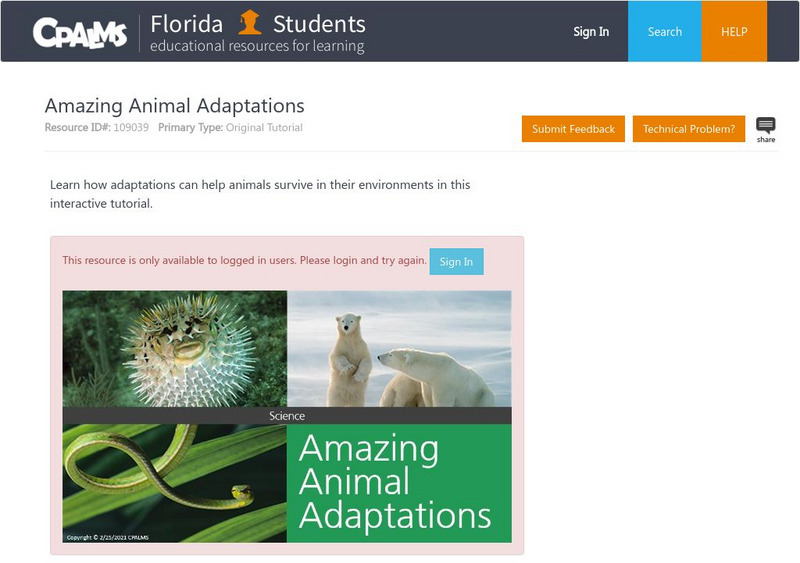Curated OER
Lesson 16: DNA Technology
Students research different areas of biotechnology. In this biology lesson, students create a presentation about their research. They debate the topic presented and share their views on the subject.
Curated OER
Natural Selection And Evolution
Seventh graders investigate the concept of natural selection and its relationship to the theory of evolution. They conduct research using a variety of resources and use the information to create a class presentation and open up the...
Curated OER
Dinosaurs 1: Where Are the Dinosaurs?
Students explore dinosaurs. In this dinosaur identification lesson, students watch video clips for different dinosaurs from the Discovery Kids website. Students discuss the clips with their teacher. Students may then role play the...
Curated OER
Pets: Oh Behave
Students develop an understanding of how innate and learned behaviors and the environment determine behavior.
Curated OER
Become an Expert
Students practice their researching techniques by preparing a presentation with little notice. In this information research lesson, students utilize the Internet to research one of several subtopics concerning panthers. Students...
Curated OER
DESIGNER GENES: ONE SIE FITS ALL?
Students explore genetic engineering and issues related to risks and benefits of altering agricultural products.
Curated OER
Show Some Backbone and Teach Invertebrates
Fifth graders identify two similarities and two differences between two phyla, assign fictitious invertebrate to its phylum and explain why it belongs in that grouping, and construct member of given phylum and explain why it should be...
Curated OER
A PRICELESS Collection
Students read a story about the life of Russian plant breeder Nikolai I and Vavilov and the national seed bank he established. They research the Irish Potato Famine of the late 1840s and identify the cause for this famine and make...
PurposeGames
Purpose Games: Inherited Traits vs. Learned Behavior
Choose the picture that shows a learned behavior or an inherited trait.
Better Lesson
Better Lesson: Why Are Some Animal Groups So Successful?
Using squirrels as an example, young scholars will understand that some animal groups' inherited traits enable them to adapt and spread into many environments. Included in this lesson are videos showing the lesson in action, discussion...
Utah STEM Foundation
Utah Stem Action Center: Inherited Traits
Ever wondered why you might look like your parents? Or an animal cub my look like its mom? Learn about inherited traits with this quick and easy lesson.
The Association of the British Pharmaceutical Industry
Abpi: Genes and Inheritance
A complete, student-paced lesson on genetics and inheritance. Students work their way through illustrations and animated tutorials, and answer review questions along the way. There is a self-checking quiz at the end of the lesson.
Better Lesson
Better Lesson: Would Your Animal Survive Here? Day 1
Determine whether an animal can survive in a different environment than its own based on its inherited traits.
Concord Consortium
Concord Consortium: Stem Resources: Modern Genetics
Try your hand at mating dragons to learn about genetic recombination, meiosis, and inherited traits. Understand how chromosomes separate in meiosis with a science animation. Then change alleles for the dragons to see what happens to...
Cold Spring Harbor Laboratory
Dna From the Beginning: Sex Linked Hemophilia in the Royal Romanov Family
An animated pedigree clearly explains the way hemophilia was inherited in the Romanov family. Interpreting pedigrees and sex-linked crosses should be much easier to understand after going through this tutorial.
Cold Spring Harbor Laboratory
Dna From the Beginning: Genes Come in Pairs
This animated lesson will explain how genes are inherited in pairs, one from the mother and one from the father.
Cold Spring Harbor Laboratory
Dna From the Beginning
At DNA from the Beginning, choose from classical genetics, molecules of genetics, genetic organization and control. Each concept is explained through animation, an image gallery, video interviews, biographies and links.
CPALMS
Florida State University Cpalms: Florida Students: Amazing Animal Adaptations
Explore various characteristics and adaptations that help organisms survive in different environments.
Cold Spring Harbor Laboratory
Dna From the Beginning: Genetic Inheritance Follows Certain Rules
Find out what happened when Mendel crossed two hybrid pea plants. The animations do a good job explaining why these crosses produce a 3:1 ratio of traits.
Cold Spring Harbor Laboratory
Dna From the Beginning: Classical Genetics
This article from DNA from the beginning is loaded with goodies about genetics and DNA. Starting with Mendel all the way through the concept of DNA, you will see how life is given certain characteristics. Some animations and audio clips...
CK-12 Foundation
Ck 12: Fourth Grade Science: Life Science: Learned Behavior of Animals
[Free Registration/Login may be required to access all resource tools.] Introduces learned behaviors and the different methods of learning.
Howard Hughes Medical Institute
Hhmi: Biointeractive: Visualizing Gene Expression
Through a series of videos and narrated animations, learn how evolution affects gene expression in species. Find out how visualizing gene expression can help explain what a specific gene does.


